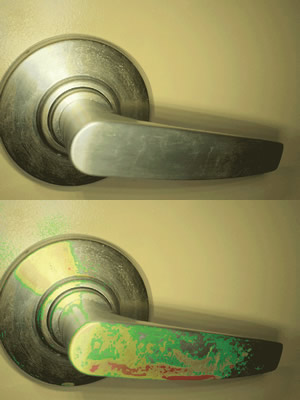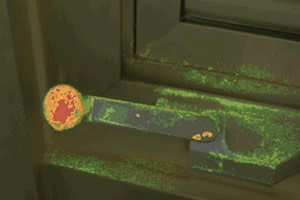Ways School Administrators Can Keep Students and Staff Healthy this Winter

PHOTOS COURTESY OF OPTISOLVE
According to the Centers for Disease Control and Prevention (CDC), the flu season is very unpredictable. It’s timing, duration, and severity can vary from year to year. In much of North America, the peak season for the flu is December through March; however, it has been known to arrive as early as October and extend into May.
While the logistics of the flu season may vary, what we do know is this:
- Each day in the U.S, about 55 million students and seven million staff use more than 130,000 public and private schools;
- While people of all ages get sick with the flu, school-aged children tend to have a higher rate of flu illness compared to most other groups;
- Because of the close proximity of children and staff in schools, the flu can spread very fast, causing many people to become ill rather quickly; and
- Flu germs can spread by inhalation or by touching droplets of flu germs on surfaces (the result of someone coughing or sneezing).
We should note that influenza is not the only disease of concern during the winter months. It is the winter season when more children come down with colds, strep throat, bronchiolitis, pneumonia, even cases of norovirus are more frequent during the winter months.
As to influenza, school administrators may think this can be addressed by ensuring children are vaccinated. However, according to the CDC, less than 60 percent of American kids were vaccinated and just a little more than 40 percent of U.S. adults received the flu vaccine in 2016. As to the other winter illnesses just mentioned, either there are no vaccines available to protect children, or if there are, they are used only under specific circumstances.
This puts considerable burden on school administrators and custodial workers to keep their schools healthy. Fortunately, this is possible. What may be necessary is a new type of winter cleaning and maintenance program. One that begins by determining where germs and pathogens are located in a school setting and then, implementing cleaning programs that help eliminate them.
Surface Assessments
Many school administrators conduct various types of “audits” or assessments, analyzing, for instance, water and energy consumption in schools with the goal of reducing both. However, rarely is what is called a “surface assessment” conducted.

PHOTO COURTESY OF OPTISOLVE
Unseen Culprits. School administrators should seriously consider conducting surface assessments. They are designed to analyze and determine where pathogens may be hiding in a school facility. Once the assessments are complete and the pathogens are located, the administrators can then institute cleaning practices and procedures to eliminate them. One of the best techniques is using surface imaging technology, which provides information similar to what is shown above.
This too is a type of audit. However, a surface assessment is designed to analyze and determine where pathogens may be located—if not hiding—in a school facility. While not all pathogens have the potential of spreading disease, the possibility is high enough that school administrators should know where they are located, and with this information, institute cleaning practices and procedures to eliminate them.
According to Brad Evans with OptiSolve, a company that conducts surface assessments, technology is making it much easier for us to do this. “One of the first big technological advances in this area was the use of adenosine triphosphate, better known as ATP,” he says. “This technology, introduced in the cleaning industry about a decade ago, detects if living cells are [present] on a surface. The results are available in seconds, not days, as when using a Petri’s dish.”
However, Evans indicates that new imaging technologies are now available that provide more information—and more precise information—about surface pathogens than has been possible with ATP. Surface imaging technologies capture images of pathogens on surfaces and generate maps, indicating where they are present and in what numbers.
“Essentially, this provides us with a ‘story’ of what’s happening on a surface,” explains Evans. “With this information, school administrators and cleaning professionals know where pathogens are located and can then determine what cleaning steps and practices should be taken to eliminate pathogens and their possible threats to health.”
The Next Steps
Eliminating these pathogens invariably requires the use of disinfectants. But according to James Flieler, with Charlotte Products, a manufacturer of professional cleaning solutions, many school administrators and custodial workers are not well-versed on how to use disinfectants properly. “Disinfectants are powerful and very effective cleaning agents designed to keep people in schools and all types of facilities healthy. But using them properly is crucial.”
Flieler adds that if a new approach to winter cleaning is being implemented, the proper use of disinfectants “should be at the top of the list.” Among his suggestions are the following:
Only use disinfectants where needed. “Often cleaning professionals start using them everywhere. This is wasteful, costly, and unnecessary.
Surfaces must be cleaned first and then disinfected. “Cleaning is the process of removing soils from a surface. Disinfecting is the process of killing pathogens on a surface. The disinfectant will be more effective when the soils are removed.”
Check the “kill claims” on the disinfectant. Every disinfectant will list the types of pathogens it is designed to kill. “If you are not sure, select a ‘broad-range’ or ‘wide-spectrum’ disinfectant, designed to kill many types of pathogens.”
Avoid being “off-label.” This occurs when a disinfectant is not being used per manufacturer’s instructions. Most all disinfectants have different diluting ratios, concentrations, dwell times, and kill claims, as discussed earlier.
While Flieler did not mention it, some cleaning experts and public health officials now suggest rotating disinfectants. Just as we can develop immunities to antibiotics, it is believed that pathogens can develop immunities to disinfectants. Rotating disinfectants—using different types with different chemical formulations—can help prevent this.
Other New Winter Protocols to Follow
While our emphasis so far has been on keeping schools healthy this winter, there are other winter cleaning initiatives that should be taken as well, according to Flieler. But this time, these are designed to protect school assets and keep schools clean and safe.
For instance, before the cold of winter sets in, floors should be refinished. Many types of floor finishes will not adhere appropriately under very cold, dry conditions. “Refinishing the floor before the cold of winter helps ensure the finish adheres properly,” adds Flieler. “This also helps protect the floor from moisture, snow, ice, and the big culprit, ice melt.”
Carpet should be cleaned during the winter months. The typical practice is to delay carpet cleaning until spring arrives. This can create two fundamental problems, according to Flieler:
- The larger concentration of soil build-up in the carpet can make the carpet harder to clean and clean effectively.
- Soils in the carpet can act likely microscopic daggers. With foot traffic, they can cut into carpet fibers, which can reduce the longevity of the carpet.
Finally, Flieler suggests that this winter, school administrators and custodial workers “sit down and create a winter school cleaning and maintenance plan.” The essence of this plan is to determine what areas of schools need the most attention and which can get by with less. “This is a form of work-loading. But it helps ensure human resources and financial resources are put to their best use during the winter season.”
This article originally appeared in the School Planning & Management October 2018 issue of Spaces4Learning.